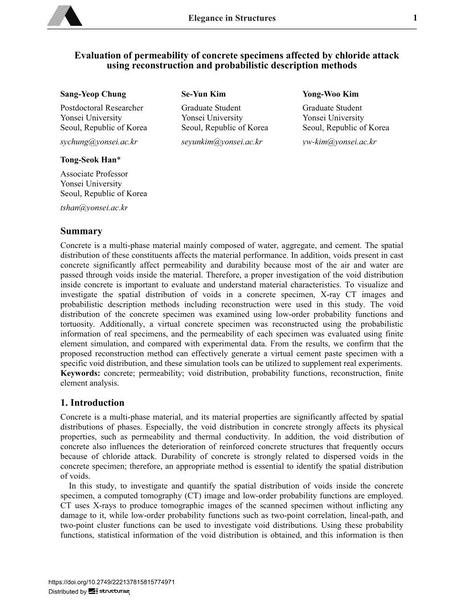Evaluation of permeability of concrete specimens affected by chloride attack using reconstruction and probabilistic description methods

|
|
|||||||||||
Bibliografische Angaben
| Autor(en): |
Sang-Yeop Chung
Se-Yun Kim Yong-Woo Kim Tong-Seok Han |
||||
|---|---|---|---|---|---|
| Medium: | Tagungsbeitrag | ||||
| Sprache(n): | Englisch | ||||
| Tagung: | IABSE Conference: Elegance in structures, Nara, Japan, 13-15 May 2015 | ||||
| Veröffentlicht in: | IABSE Conference Nara 2015 | ||||
|
|||||
| Seite(n): | 274-275 | ||||
| Anzahl der Seiten (im PDF): | 4 | ||||
| Jahr: | 2015 | ||||
| DOI: | 10.2749/222137815815774971 | ||||
| Abstrakt: |
Concrete is a multi-phase material mainly composed of water, aggregate, and cement. The spatial distribution of these constituents affects the material performance. In addition, voids present in cast concrete significantly affect permeability and durability because most of the air and water are passed through voids inside the material. Therefore, a proper investigation of the void distribution inside concrete is important to evaluate and understand material characteristics. To visualize and investigate the spatial distribution of voids in a concrete specimen, X-ray CT images and probabilistic description methods including reconstruction were used in this study. The void distribution of the concrete specimen was examined using low-order probability functions and tortuosity. Additionally, a virtual concrete specimen was reconstructed using the probabilistic information of real specimens, and the permeability of each specimen was evaluated using finite element simulation, and compared with experimental data. From the results, we confirm that the proposed reconstruction method can effectively generate a virtual cement paste specimen with a specific void distribution, and these simulation tools can be utilized to supplement real experiments. |
||||
| Stichwörter: |
Beton Finite-Elemente-Analyse Rekonstruktion Permeabilität
|
||||
